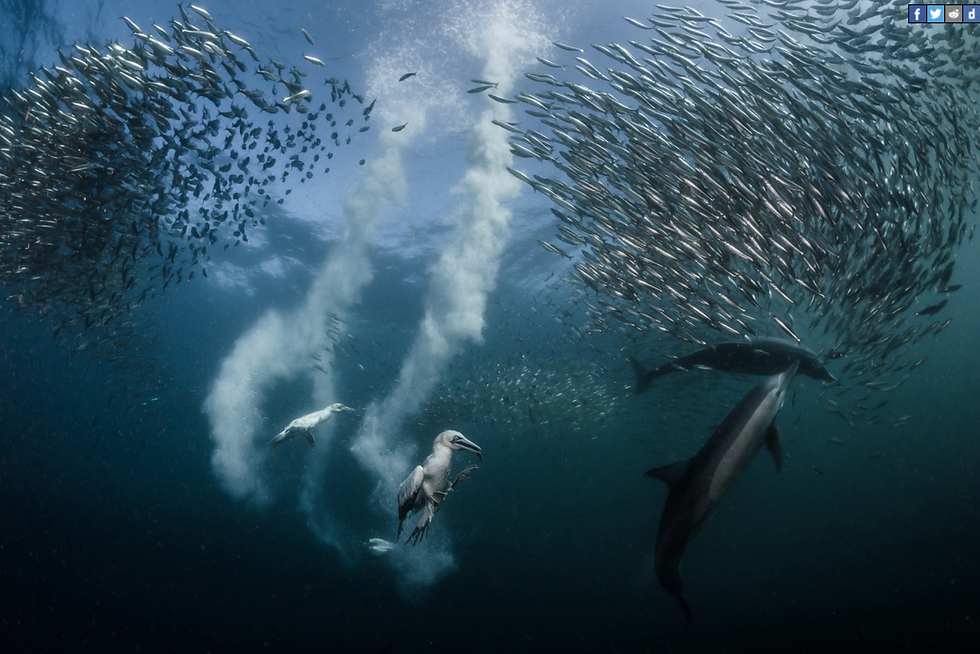The Sardine Run: a Question of Access, and a Climate on the Brink
- Danel Wentzel
- Aug 11
- 4 min read
There are moments in the natural world so vast and so raw that they force a pause. They humble you. They challenge your perception of scale and time. For me, witnessing South Africa’s Sardine Run is one of those moments.

It is often described as the marine equivalent of the Serengeti’s great wildebeest migration, and in terms of sheer biomass, it is arguably even more immense. But more than just a wildlife spectacle, it is a powerful, untamed force that holds a mirror to our world, raising questions about privilege, and a future that hangs in the balance.
Every South African winter, as the cold season settles in from June to July, a colossal exodus begins. Billions of South African pilchards (Sardinops sagax)—a species we colloquially call sardines—leave their spawning grounds on the cool waters of the Agulhas Bank. Guided by the cold water currents of the Benguela Current, they embark on an epic journey north along the Wild Coast, a rugged, beautiful stretch of hinterland that feels worlds away from the bustling cities.
South African pilchards (Sardinops sagax) on the annual Sardine Run.
This pilgrimage is what triggers the action. The shoals are so dense and so large they can be spotted from space, creating a living, breathing river of silver that attracts a spectacular cast of predators. This is a scientific fact and a narrative truth: nature’s largest buffet is open for business.
I remember my first time witnessing it—the pure, beautiful chaos of it all. The ocean’s top predators work in perfect synchrony: acrobatic common dolphins herding the sardines into tight, swirling "bait balls." Then, the sharks—dusky sharks and bronze whalers—arrive, using their powerful bodies to tear through the glittering spheres. From the sky, thousands of Cape gannets dive-bomb into the water like feathered missiles, adding to the breathtaking frenzy. It is an untouched, wild beauty that makes you feel both exhilaratingly small and profoundly alive.
But who gets to see it? This is a question I’ve carried with me ever since I became a trip leader. The Sardine Run is a jewel in South Africa’s crown, yet for many of the people who call the beautiful Wild Coast home, this natural inheritance remains tragically out of reach. The cost of a week-long expedition, which funds the boats, fuel, and experienced guides, often prices out the very communities who live alongside this natural wonder. As travelers, we have a responsibility to ask these hard questions and ensure that our presence not only preserves these ecosystems but also supports the local people who are its true stewards.

A Delicate Balance: The Sardine Run in a Warming World
The Sardine Run is a testament to the incredible, and increasingly fragile, balance of our oceans. As a marine biologist, I know that the migration is not simply a mass movement; it is a complex hydrodynamic event, and frankly, a scientific mystery. The run is highly dependent on a specific set of oceanic conditions that create a narrow, cool-water corridor for the sardines to follow.

This migration is a battle against the powerful, warm Agulhas Current, which flows in the opposite direction. What makes the run possible are sporadic, cold-water phenomena like cyclonic eddies and coastal upwellings. These are essentially giant, swirling pockets of cooler water that break away from the main current, creating temporary northward-flowing currents and bringing nutrient-rich water from the deep to the surface. It is a "Waterfall Bluff gateway" hypothesis proposed by scientists that suggests the run's success hinges on these very eddies. Without these specific physical oceanographic events, the sardines are essentially trapped in water that is too warm for their survival.
This brings us to a terrifying question: For how long will this last? The sardine run is understudied, and the data we do have is often pieced together from historical newspaper reports and sporadic scientific surveys. However, what we do know from recent research is sobering. Global warming is causing the ocean to absorb more heat, which can disrupt the frequency and intensity of these vital eddies. As coastal waters warm, the sardines may find their traditional migratory path not only more difficult but biologically stressful, leading to a decline in their health and survival.
Some other 'players' on the run include Humpback whales, Bryde's whales, Bottlenose dolphins, and various shark species like Duskies and Oceanic Blacktips.
This isn't just about the sardines; it's about the entire ecosystem. Fewer or more fragmented runs mean less food for everything from dolphins and whales to the endangered Cape gannet. This once-reliable seasonal feast could become a thing of the past, creating a cascade of ecological collapse. When we jump into those waters, we are not just witnessing a migration; we are bearing witness to a phenomenon that may one day cease to exist in its current form. This awareness adds a profound urgency to every dive and every sighting. .
Planning Your Pilgrimage
If this has inspired you to embark on this journey, here is some practical guidance on how to plan and book your trip with Wild Mermaid Expeditions.
When to Go: The most active period is from early June to mid-July. This is a small window, so planning well in advance is essential.
Where to Go: The Sardine Run spans the entire Wild Coast, but the most consistent action is typically found in hotspots like Port St. Johns and Mdumbi.
What to Expect: Prepare for long, full days on the water. We prioritise quality experiences over sheer numbers, so while we cannot guarantee a bait ball every day, we can promise a journey of discovery and a new appreciation for our marine world.
How to Book: Due to the intimate nature of our expeditions, spots are limited. We encourage you to visit our website and reserve your spot to ensure you don't miss out on this once-in-a-lifetime adventure.

The Sardine Run matters because it is a vital part of our planet's great web of life. It sustains predator populations, fuels local economies, and, most importantly, provides a powerful story of resilience and interconnectedness. It reminds us that our oceans are not just a backdrop for our adventures; they are living, breathing entities whose fate is inextricably linked to our own.














Comments